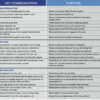Considering Costs U.S. Hospitals choose Anticoagulant Rivaroxaban Over Warfarin
NEW YORK (Reuters Health) – U.S. hospitals save money when they use the novel oral anticoagulant rivaroxaban instead of warfarin to treat patients with venous thromboembolism (VTE), a new analysis finds.
“These days it’s important to consider the cost of new drugs to the health system,” Dr. Steven Deitelzweig from Ochsner Health System in New Orleans, Louisiana, noted in an interview with Reuters Health.
“This retrospective observational analysis had an ample number of patients, they had very good clinical outcomes with rivaroxaban, and we also demonstrated that those clinical outcomes could be achieved with a notable reduction in the all-important utilization side of healthcare,” he said.
It’s estimated that VTE affects more than 900,000 Americans each year, at a cost to the healthcare system between $13 and $27 billion.
Dr. Deitelzweig and his colleagues did an economic analysis of rivaroxaban versus low-molecular-weight heparin (LMWH)/warfarin for VTE in the hospital setting.
Using Truven MarketScan Hospital Drug Database, they identified more than 2,400 older adults hospitalized for primary VTE between 2012 and 2013. They created two groups of 1,223 patients each. Each group included 751 pulmonary embolism (PE) patients and 472 deep vein thrombosis (DVT) patients.
According to the analysis, total hospitalization costs – including room rate, laboratory tests, inpatient procedures, pharmacy costs and all other inpatient services – were significantly lower and length of stay was significantly shorter for patients treated with rivaroxaban rather than LMWH/warfarin.
Patients receiving rivaroxaban spent an average of 1.5 fewer days in the hospital than their peers on LMWH/warfarin (3.7 versus 5.2 days, p<0.001).
“This finding is consistent with the length of stay reduction found in the EINSTEIN VTE clinical trials,” the researchers note in their poster presented March 7 at the Society of Hospital Medicine annual meeting in San Diego, California.
“Length of stay is one metric that we track quite closely and care about. Even one day less in a hospital is a significant cost savings and allows hospitals that are very busy to take care of the next patient, as appropriate,” Dr. Deitelzweig told Reuters Health.
The rivaroxaban group had an adjusted average cost savings of $1,888 per admission compared with the LMWH/warfarin group ($8,387 versus $10,275; p<0.001), the study found.
Limitations of the study include the fact that patient medical history was limited to the patient’s current admission. Outpatient treatment prior to admission, particularly whether they had received either rivaroxaban or LMWH/warfarin prior to admission was unknown. And despite propensity score matching and further statistical modeling, there remains the potential for unmeasured confounders, they note.
The study was funded by Janssen Scientific Affairs, LLC. Janssen Pharmaceuticals markets rivaroxaban under the trade name Xarelto. Four authors are employees of Janssen Research and Development, LLC.



